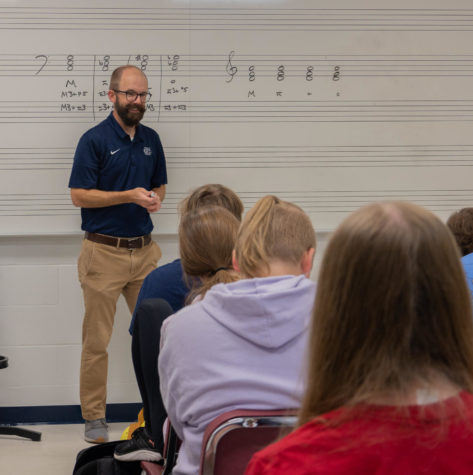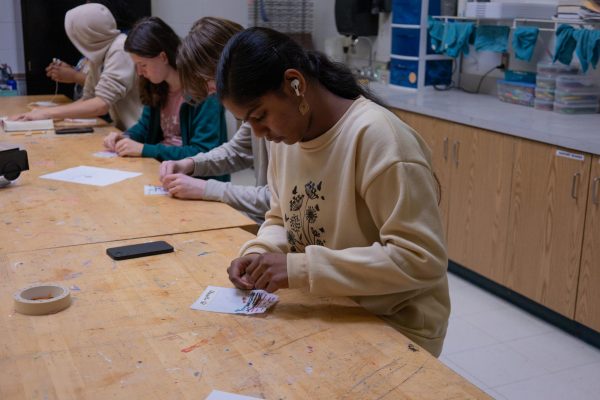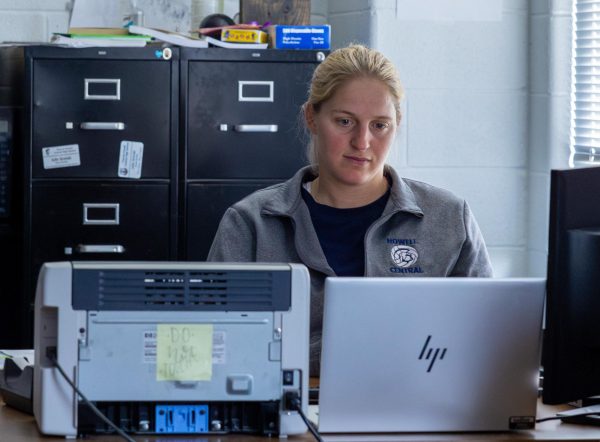Finding the Tempo
Positive attitudes help AP Music Theory students adjust to large class size
Mr. Andy Messerli and his students work together to comprehend the complexeties of music theory. This class has faced many changes over the years, going from Central’s smallest class, to it’s largest.
Tucked away within room 005b, during first hour every morning, students from all different backgrounds and experiences sit for AP Music Theory, taught by Mr. Andrew Messerli. This fine arts credit explains in depth what makes up music, tackling topics such as chord progression and interval notation.
Historically one of the school’s smallest classes, this year has brought on record-breaking numbers of enrollment; a class that was once 12 has turned to 30. The class that was once canceled is now stronger than anyone could’ve imagined due to the attitudes of the students taking it. Cassie Heyn, a senior involved in marching band, pep band, and many other musical escapades, took this class to understand the music she performs better.
“I took this class because I was curious and always interested in music. I wanted to take it for a while and just never had the opportunity before this year,” Heyn said.
Music theory can be a difficult subject to grasp, especially for those not heavily involved in the fine arts. What makes up music isn’t often given much thought to those who do not specifically study it. Theory tackles what music is composed of and separates it from simple noise, a complex and difficult thing worthy of years worth of study. Mr. Messerli describes music theory.
“We’re talking about how music is built, the construction of it, the building blocks of it. A choir and a band might be talking more about the performance aspect. [Theory] is looking behind the curtain a little bit. Here’s why composers choose this chord. Here’s why this note works where that one might not. So it’s all about the construction of music,” Mr. Messerli says.
This bizarre and unprecedented situation, which could have led to some uncomfortable class periods, is surprisingly seen as positive for its students. The tight first-hour classroom, previously ping pong storage closet, could have led to animosity between its inhabitants, but the perseverant tone has remained consistent and strong in the pupil’s attitudes. Liam Lashely, a senior and choir representative shares some positive aspects of the class size.
“I know originally, this class before us was extremely small and was taken in a choir room whereas this year we had 30 some odd kids shoved in a closet and I think it works the same honestly. I think we’re closer together. And we could sing more often because you know we’re not in masks and we don’t have to worry about social distancing,” Lashley said.
The day-to-day class hasn’t changed much over the years either, the routine of things hasn’t changed and the only difference has seemed to be simple and fixable attention issues. This year students are able to rely on more people than before due to the enrollment flux and this has led to a tighter bond than could have been imagined before.
“When somebody has a problem with a particular concept, people are able to jump in. Everybody has their own strengths and weaknesses so students that might struggle with one area are able to help with another. I see this continue on not only in our classroom but into the rehearsals as well when I see the students later on for Symphonic Band, Wind ensemble, and marching band”, Messerli says.

Even though it isn’t as well known as other classes and was nearly cancelled before this year, those enrolled in AP Music Theory believe deeply that it is important to the culture of FHC.
“I feel like we need to have classes like [AP Music Theory] for people that are still interested in music but don’t want to go through the whole thing of multiple music classes. It’s a music opportunity for people that aren’t in a band or choir; you don’t have to be in a band class to take the class. You can just take the class if you want to,” Heyn said.
Despite the class’s history and near cancellation, AP Music theory’s future is strong and promising. Enrollment is on the upward trend and the passion of the students taking it does nothing but pave the way for future success. Like many fine arts programs, it’s the students that make it special and the passion they have is strong. The course seems to not be going anywhere any time soon and its impact is only growing.
Your donation will support the student journalists of Francis Howell Central High School. Your contribution will allow us to purchase equipment and cover our annual website hosting costs. FHCToday.com and our subsequent publications are dedicated to the students by the students. We hope you consider donating to allow us to continue our mission of a connected and well-informed student body.






